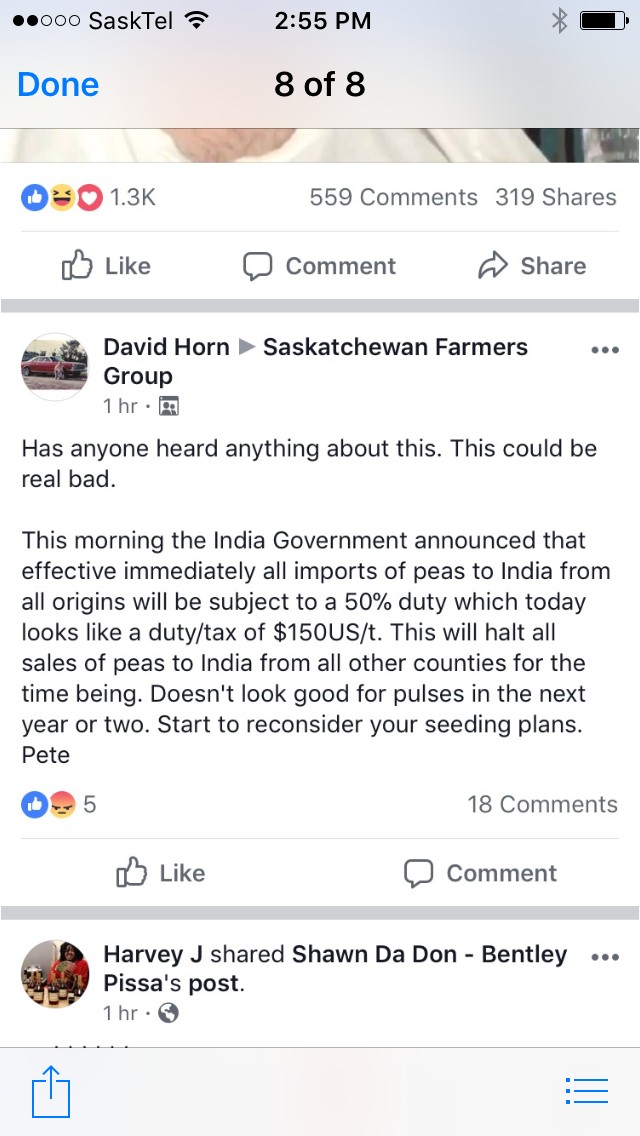It looks very obvious to me the yellow pea export market is going to be the shits.
Announcement
Collapse
No announcement yet.
Yellow Peas
Collapse
Logging in...
Welcome to Agriville! You need to login to post messages in the Agriville chat forums. Please login below.
X
-
Its all connected....there better be some research into root rot or some years Canadian supply could be small. But market access is needed regardless.Originally posted by bucket View PostCan someone in the know tell me why market access isn't more important than new varieties. ....and why it isn't in saskpulse's wheelhouse?
Comment
-
Market access is a huge part of Pulse Canada's program. SpG already funds it thru it's national partner.Originally posted by bucket View PostCan someone in the know tell me why market access isn't more important than new varieties. ....and why it isn't in saskpulse's wheelhouse?
And they do have a marketing newsletter to keep producers in the newsletter. That came out of the green lentil marketing study in about 2006 when Large green lentils hit 8 cents a lb. Then they expanded it to all pulses.
Comment
-
Average SK prices for yellows didn't drop below $10 till July last year. Quotes were as high as 14.07 late Feb early Mar.
High prices cure high prices
Comment
-
Seen this today , not sure how accurate though ....
If so it will further pressure prices down in all pulses
Still by far the biggest issue in pulses is root rots and and understanding what is exaggerating the problem beyond crop rotation and why it is showing up in dry soils and areas. It's not only a wet soils issue. There are other factors that greatly exaggerate the problem but it's taboo to even mention . If they don't address the root rot issue completely the pulse industry will collapse and all the other things they do are / will be a complete waste of time and money if we can't grow pulses . Fusarium root rot is going to take out the pulse industry if not addressed .
Comment
-
Sask Pulse is exactly working on the two main issues mentioned. A bunch of research into root rot for at least last three years. Varieties with some resistance are in the pipeline.
And market access is the number one effort thru Pulse Canada. Which Sask Pulse funds in a major way along with other provinces and trade. In fact efforts have basically been doubled in last few years. It’s an immense complex area.
This news out of India was anticipated by no one.
Comment
-
Originally posted by Quadtrack View PostSask Pulse is exactly working on the two main issues mentioned. A bunch of research into root rot for at least last three years. Varieties with some resistance are in the pipeline.
And market access is the number one effort thru Pulse Canada. Which Sask Pulse funds in a major way along with other provinces and trade. In fact efforts have basically been doubled in last few years. It’s an immense complex area.
This news out of India was anticipated by no one.
We already know the cause of root rots.
Why throw money away. Quit shielding BASF.
That news from India wasn't a surprise... My contacts in Saudi Arabia and China have been talking about it for two weeks...
Is the announcement on Friday out of India also going to be a complete surprise?
Comment
-
Well ok then.Originally posted by Klause View PostWe already know the cause of root rots.
Why throw money away. Quit shielding BASF.
That news from India wasn't a surprise... My contacts in Saudi Arabia and China have been talking about it for two weeks...
Is the announcement on Friday out of India also going to be a complete surprise?
Know the cause of root rot? Nothing to do with BASF. And the work is toward a solution.
Comment
-
Originally posted by Quadtrack View PostWell ok then.
Know the cause of root rot? Nothing to do with BASF. And the work is toward a solution.
How come organic peas get no root rot. How come it is more prevalent in fields treated with sulfenafanacil?
Why doesn't it show up till after herbicide application?
How come our fields are disease free and the one down the road is a write-off.
That "flash" or transient crop yellowing as BASF calls it... That's what creates a pathway for infection.
The Rack has done a very interesting study... That spga does not want to publicize.
Comment
- Reply to this Thread
- Return to Topic List
Comment